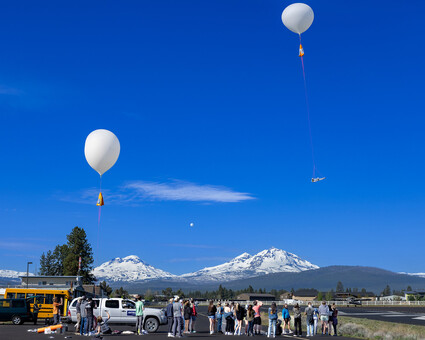Students launch science balloons
Last updated 5/23/2023 at 4:45pm

Photo by Jerry Baldock
Sisters science students sent experiments to 80,000 feet in a balloon launch from Sisters Eagle Airport
On a sunny spring day in Sisters, Tuesday, May 16, Sisters High School (SHS) chemistry students launched two stratospheric balloons from Sisters Eagle Airport, loaded with students' experiments.
The experiments are attached to what is known as a payload - items that will help students determine what happened while the balloon was floating in the atmosphere at over 80,000 feet.
The chemistry classes have been launching weather balloons every year since 2015. This year, 37 students participated.
The students, led by teacher Rima Givot, went through the entire process of launching two balloons via student teams.
"It is entirely student-led, so each team has different responsibilities when launching the balloon, and we are just here to support them," said Givot.
This project is made possible with the leadership of Steven Peterzen of the stratospheric ballooning company ISTAR, and funded through a grant recently awarded to the program by Battelle Memorial Institute in partnership with the Sisters School District. Students receive mentorship from Rod Moorehead and Ron Thorkildson.
Students put together all aspects of the project, including budgeting, flight operations, talking with landowners where the balloon might come down, and putting together the experiments.
Peterzen supports the project every year with his expertise and equipment.
"It's my goal to connect the students with these heads of meteorology and scientists and make connections if they want to go out and get a job in that field; they have already been published with this project in high school," said Peterzen.
The balloons are filled with helium, which allows them to float into the atmosphere. Students are applying gas performance to what happens to the balloon in the upper atmosphere, and learning about temperature effects, humidity, and altitude.
Students will then construct a profile of the different atmospheric layers, based on the tests on the load, and apply chemistry knowledge to the hands-on experience.
GoPro cameras are also attached to the payload, allowing students to see what things looked like floating upwards of 80,000 feet.
Givot said, "We watched the flights of both balloons as they followed the predictions closely. We could see them when they reached their highest points above 81,000 and 87,000 feet before they burst. They landed between Redmond and Bend just off Highway 97, a few miles apart."
The students used GPS and radio trackers to monitor their locations, and a drone to help find the payload once they had landed. The parachutes, built and designed by students, brought down the payloads smoothly, and all the experiments were intact.
Principal Steve Stancliff said, "With this, the students can do the science they are learning about in the classroom. It is more abstract in the classroom, and this way, they are hands-on experience. Every student is invested in a particular role."

















Reader Comments(0)